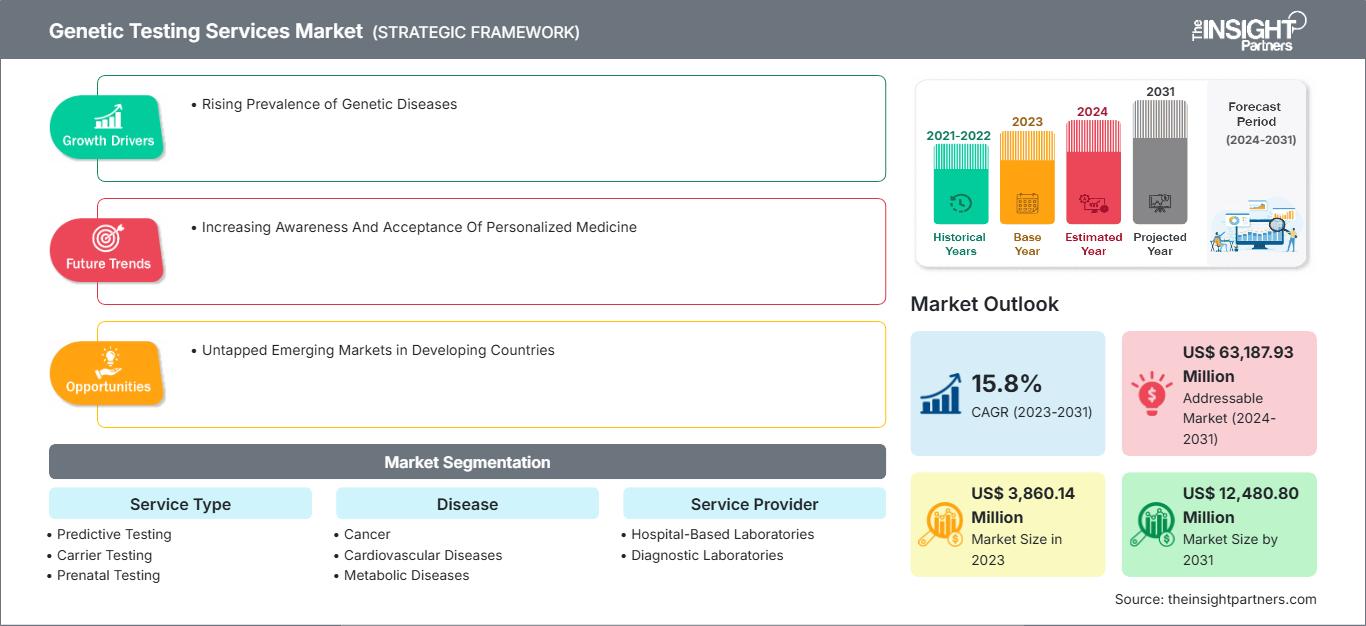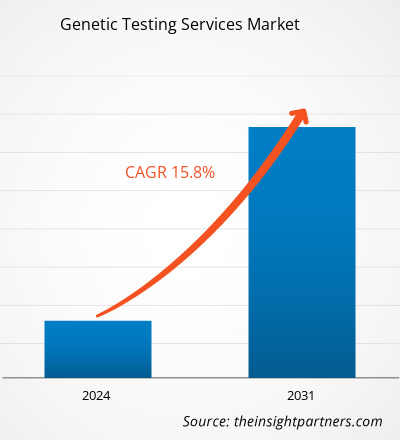预计到 2031 年,基因检测服务市场规模将从 2023 年的 38.6014 亿美元增至 124.808 亿美元。预计该市场在 2023 年至 2031 年期间的复合年增长率为 15.8%。人工智能驱动的基因检测可能会在未来几年为基因检测服务市场带来新的趋势。
基因检测服务市场分析
推动基因检测服务市场发展的因素包括报销计划的推出、对高效治疗选择的需求不断增长以及研究中心实施创新技术。人们对基因检测优势的认识不断提高以及消费者在医疗保健方面的支出增加,正在推动基因检测服务市场的增长。对用于诊断慢性病的基因检测需求的不断增长,支持了参与者投资于新服务的开发和扩张战略。此外,遗传疾病和癌症发病率的上升对基因检测行业的发展至关重要。
基因检测服务市场概览
基因检测是一种医学和科学程序,涉及检查和分析人体DNA,以了解其基因组成和遗传信息。由于遗传疾病和癌症发病率的上升,英国的基因检测服务市场预计将大幅增长。例如,根据英国遗传联盟2021年的数据显示,罕见病影响着英国350万人;即每17人中就有1人。根据英国基因人2023 (Gene People UK 2023) 报告,估计每25名儿童中就有1名患有遗传性疾病,这意味着英国每年有3万名婴儿和儿童被新诊断出患有遗传性疾病,超过240万名儿童和成人患有遗传性疾病。
在德国,无创产前检测已于2022年成为公共报销的检测项目。此外,基因组学领域正在取得重大进展,为增强个性化医疗的可及性铺平了道路。英国已建立基础设施以支持更广泛的基因组检测可及性,包括一个由基因组实验室和提供临床服务的基因组医学中心组成的全国网络。2019年,政府宣布了“英国早期疾病检测研究项目”,这是一项重要的新举措,重点关注成人的主要慢性疾病,包括所有癌症、心血管疾病和其他此类疾病。
自定义此报告以满足您的要求
您将免费获得任何报告的定制,包括本报告的部分内容,或国家级分析、Excel 数据包,以及为初创企业和大学提供超值优惠和折扣
基因检测服务市场: 战略洞察

-
获取本报告的主要市场趋势。这个免费样本将包括数据分析,从市场趋势到估计和预测。
基因检测服务市场驱动力与机遇
遗传病患病率上升利于市场增长
遗传病的患病率在世界范围内不断上升,并严重影响着人们的健康。遗传病表现出许多不常见的症状,且大多无法治愈。根据世界卫生组织 (WHO) 2021 年的数据,每 1,000 人中就有 10 人患有单基因疾病,这意味着全世界有 7000 万至 8000 万人患有任何一种单基因疾病。根据全球基因数据,全球已发现约 7,000 种已知的罕见疾病和病症,而且每年都有更多疾病被发现。2022 年,美国 MJH Life Sciences 的一份报告估计,全球每年有 30 万新生儿患有镰状细胞病,占全球人口的 ∼5%。 2020 年 6 月,根据诺华公司(瑞士)的报告,英国有 15,000 人患有镰状细胞病,每年有 270 名新生儿被诊断出患有这种疾病。因此,遗传病患病率的上升刺激了对基因检测的需求,进而推动了基因检测服务市场的增长。
发展中国家尚未开发的新兴市场
中国、印度、巴西和墨西哥等新兴国家为市场参与者提供了巨大的增长机会。高收入国家和中低收入国家的遗传服务质量和可用性可能有所不同。例如,在美国、澳大利亚、加拿大、英国和其他欧洲国家,遗传服务非常先进、成熟且广泛。这些服务包括新生儿筛查、携带者识别筛查和产前诊断。然而,在许多高收入国家,在多种环境中提供的遗传服务仍然需要改进的评估系统。主要市场参与者正专注于制定协议、合作、伙伴关系和扩张等战略和举措,以提高其在这些国家的产品可用性、可及性和分销网络,因为这将有助于他们满足日益增长的早期诊断和治疗需求。
中国政府将基因组学确定为国家经济和社会发展第十四个五年规划(2016-2020 年)中的重要战略领域。2016 年,中国科学院启动了精准医学计划,这是一项为期 14 年、耗资 92 亿美元的项目,旨在到 2030 年对超过 1 亿个人类基因组进行测序。2017 年 12 月,中国科技部与一项人类基因组研究项目合作,记录了 10 万人的基因组成。研究人员利用九个不同少数民族的基因数据,希望解码基因中的遗传信息。因此,预计发展中国家的新兴市场将在预测期内为基因检测服务市场的增长提供丰厚的机遇。
基因检测服务市场报告细分分析
促成基因检测服务市场分析的关键细分领域包括服务类型、疾病和服务提供商。
- 根据服务类型,基因检测服务市场分为预测检测、携带者检测、产前检测、新生儿筛查、诊断性基因检测等。预测性检测细分市场在2023年占据了最大的市场份额,预计在2023年至2031年期间将实现最高的复合年增长率。
- 按疾病细分,基因检测服务市场分为癌症、心血管疾病、代谢性疾病和其他疾病。 2023 年,癌症领域占据了最大的市场份额,预计在 2023 年至 2031 年期间将实现最高的复合年增长率。
- 就服务提供商而言,基因检测服务市场分为医院实验室、诊断实验室和其他。2023 年,医院实验室领域占据了最大的市场份额,预计在 2023 年至 2031 年期间将实现最高的复合年增长率。
按地区划分的基因检测服务市场份额分析
基因检测服务市场报告的地理范围主要分为五个区域:北美、亚太地区、欧洲、中东和非洲以及南美和中美洲。2023 年,北美占据了相当大的市场份额。近年来,美国和加拿大癌症患者数量的增加、政府资金的增加以及人口遗传病发病率的上升推动了市场的增长。根据美国政府问责局 (USGAO) 2021 年 10 月发布的估计,美国约有 2500 万至 3000 万人患有罕见病;其中近 50% 的患者是儿童。罕见病通常是基因突变的结果;据估计,80% 的罕见病与遗传有关。
此外,医疗保健、政府和私营部门越来越重视将先进方法融入精准医疗,政府和私营部门也纷纷投入巨额资金用于基因研究,预计将加速该地区基因检测服务市场的增长。
基因检测服务市场区域洞察
The Insight Partners 的分析师已详尽阐述了预测期内影响基因检测服务市场的区域趋势和因素。本节还讨论了北美、欧洲、亚太地区、中东和非洲以及南美和中美洲的基因检测服务市场细分和地域分布。
基因检测服务市场报告范围
| 报告属性 | 细节 |
|---|---|
| 市场规模 2023 | US$ 3,860.14 Million |
| 市场规模 2031 | US$ 12,480.80 Million |
| 全球复合年增长率 (2023 - 2031) | 15.8% |
| 历史数据 | 2021-2022 |
| 预测期 | 2024-2031 |
| 涵盖的领域 |
By 服务类型
|
| 覆盖地区和国家 |
北美
|
| 市场领导者和主要公司简介 |
|
基因检测服务市场参与者密度:了解其对业务动态的影响
基因检测服务市场正在快速增长,这得益于终端用户需求的不断增长,而这些需求的驱动因素包括消费者偏好的演变、技术进步以及对产品优势的认知度的提升。随着需求的增长,企业正在扩展其产品线,不断创新以满足消费者需求,并抓住新兴趋势,从而进一步推动市场增长。

- 获取 基因检测服务市场 主要参与者概述
基因检测服务市场新闻及最新发展
基因检测服务市场评估通过收集一手和二手研究后的定性和定量数据进行,这些数据包括重要的企业出版物、协会数据和数据库。以下列出了基因检测服务市场的一些发展:
- GeneDx 增强了其全基因组测序 (WGS) 产品,旨在加快诊断速度并缩短患者的诊断周期。这些新功能包括更快的快速全基因组测序 (rWGS)、口腔样本采集和重复扩增的周转时间。结合其行业领先的数据集和产品增强功能,GeneDx 提高了全基因组测序在诊断方面的可及性和有效性,最终致力于阻止或减缓常见疾病和罕见疾病的进展。 (来源:GeneDx,新闻稿,2024 年 7 月)
- Progenic 是一家总部位于美国的全球知名基因检测品牌,该公司已进军印度市场,在新德里设立了首家基因实验室,并在钦奈设立了人工智能 (AI) 和生物信息学数据中心。该品牌与当地医疗保健提供商、生育诊所和执业医师合作,扩大其业务范围,让更广泛的受众能够获得先进的基因检测解决方案。(来源:Progenic,新闻稿,2023 年 12 月)
基因检测服务市场报告覆盖范围和交付成果
《基因检测服务市场规模和预测(2021-2031)》报告对市场进行了详细的分析,涵盖以下领域:
- 基因检测服务市场规模以及涵盖范围内所有关键细分市场的全球、区域和国家/地区预测
- 基因检测服务市场趋势以及市场动态,例如驱动因素、限制因素和关键机遇
- 详细的 PEST 和 SWOT 分析
- 基因检测服务市场分析涵盖关键市场趋势、全球和区域框架、主要参与者、法规和最新市场发展
- 行业格局和竞争分析涵盖市场集中度、热图分析、知名参与者和基因检测服务市场的最新发展
- 详细的公司简介
- 历史分析(2 年)、基准年、预测(7 年)及复合年增长率
- PEST和SWOT分析
- 市场规模、价值/数量 - 全球、区域、国家
- 行业和竞争格局
- Excel 数据集
近期报告
相关报告
客户评价
购买理由
- 明智的决策
- 了解市场动态
- 竞争分析
- 客户洞察
- 市场预测
- 风险规避
- 战略规划
- 投资论证
- 识别新兴市场
- 优化营销策略
- 提升运营效率
- 顺应监管趋势






















 获取免费样品 - 基因检测服务市场
获取免费样品 - 基因检测服务市场